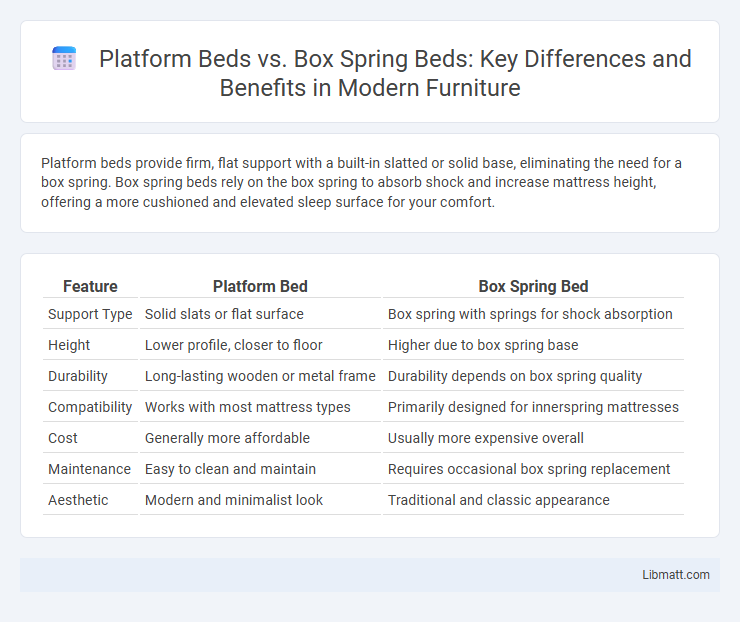Platform beds provide firm, flat support with a built-in slatted or solid base, eliminating the need for a box spring. Box spring beds rely on the box spring to absorb shock and increase mattress height, offering a more cushioned and elevated sleep surface for your comfort.
Table of Comparison
| Feature | Platform Bed | Box Spring Bed |
|---|---|---|
| Support Type | Solid slats or flat surface | Box spring with springs for shock absorption |
| Height | Lower profile, closer to floor | Higher due to box spring base |
| Durability | Long-lasting wooden or metal frame | Durability depends on box spring quality |
| Compatibility | Works with most mattress types | Primarily designed for innerspring mattresses |
| Cost | Generally more affordable | Usually more expensive overall |
| Maintenance | Easy to clean and maintain | Requires occasional box spring replacement |
| Aesthetic | Modern and minimalist look | Traditional and classic appearance |
Introduction to Platform and Box Spring Beds
Platform beds feature a solid or slatted base that supports your mattress directly, eliminating the need for a box spring and offering a modern, low-profile design. Box spring beds use a spring-filled foundation to provide extra cushioning and height beneath the mattress, often enhancing comfort and shock absorption. Understanding the structural differences between platform and box spring beds helps you choose the best support system tailored to your sleeping preferences.
Design Differences Between Platform and Box Spring Beds
Platform beds feature a solid or slatted base that supports the mattress without the need for a box spring, promoting a low-profile and modern design. Box spring beds rely on a wooden or metal frame containing springs, which adds height and traditional aesthetic appeal while providing additional mattress support and shock absorption. The design differences influence factors such as bed height, mattress compatibility, and overall bedroom style.
Mattress Compatibility with Platform vs Box Spring Beds
Platform beds offer superior mattress compatibility by providing a solid, flat surface that supports all mattress types, including memory foam, latex, and hybrid models, ensuring proper weight distribution and preventing sagging. Box spring beds require a box spring foundation, primarily designed for innerspring mattresses, potentially limiting the use of foam or hybrid mattresses without additional adjustments. Choosing the right bed frame based on mattress type enhances durability, comfort, and overall sleep quality.
Comfort and Support: Comparing Both Bed Types
Platform beds offer firm, even support with a solid or slatted base, providing enhanced stability and reducing mattress sagging for consistent comfort. Box spring beds add a layer of shock absorption and height, thanks to their spring foundation, which can improve mattress durability and offer a softer, more cushioned feel. Your choice depends on whether you prefer the firmness and streamlined design of platform beds or the traditional, cushioned support of box springs.
Durability and Lifespan Considerations
Platform beds typically offer enhanced durability due to their solid slat or panel foundation, which provides consistent support and reduces mattress wear over time. Box spring beds rely on a separate spring foundation that can sag or weaken, potentially compromising mattress lifespan and overall comfort. Investing in a high-quality platform bed often results in longer-lasting structural integrity and sustained mattress performance.
Price Comparison: Platform vs Box Spring Beds
Platform beds generally offer a more cost-effective option compared to box spring beds, as they eliminate the need for an additional box spring component. The average price for a platform bed ranges from $200 to $700, while box spring beds, including the mattress and box spring, typically cost between $400 and $1,200. Consumers save money with platform beds due to their integrated support system, reducing the total expenditure on bed foundations.
Ease of Assembly and Installation
Platform beds offer straightforward ease of assembly with fewer components, often requiring only basic tools and minimal time to set up. Box spring beds typically involve heavier parts that necessitate assembling the frame, placing the box spring, and then positioning the mattress, making installation more complex and time-consuming. Consumers seeking quick and hassle-free setup often prefer platform beds for their simplicity and reduced installation effort.
Aesthetic Appeal and Bedroom Style
Platform beds offer a sleek, modern aesthetic with clean lines and low profiles that complement minimalist and contemporary bedroom styles. Box spring beds provide a classic, traditional look with increased height and a more substantial frame, fitting well in vintage or ornate bedroom designs. Choosing between the two depends on the desired bedroom ambiance and how the bed's structure enhances overall decor.
Storage Options and Space Efficiency
Platform beds offer built-in storage options such as drawers or open space underneath the frame, maximizing room efficiency by utilizing typically unused areas. Box spring beds generally lack integrated storage, requiring separate solutions like under-bed containers or additional furniture. Choosing a platform bed enhances space optimization, making it ideal for smaller bedrooms or those needing organized storage.
Choosing the Right Bed for Your Needs
Platform beds offer built-in support with slats or a solid surface, eliminating the need for a box spring and providing a modern, low-profile design ideal for space-saving and easy maintenance. Box spring beds require a sturdy foundation box spring to absorb shock and enhance mattress longevity, making them suitable for traditional innerspring mattresses and those seeking extra cushioning. Selecting the right bed depends on mattress type, desired support level, aesthetic preference, and room configuration to ensure optimal comfort and durability.
Platform vs Box Spring Beds Infographic

 libmatt.com
libmatt.com